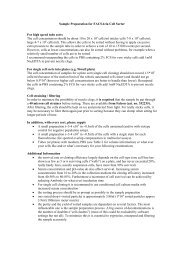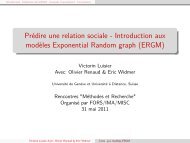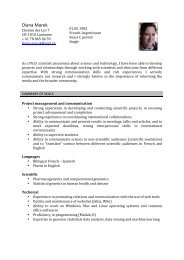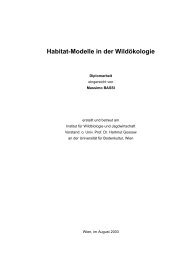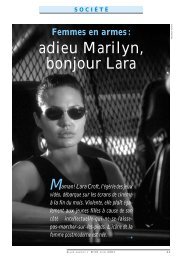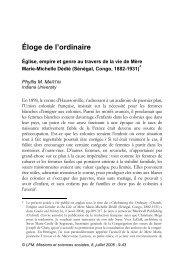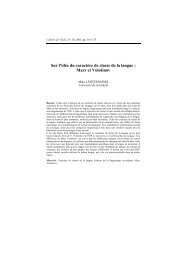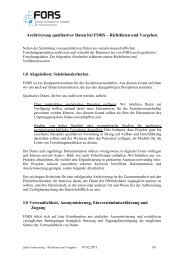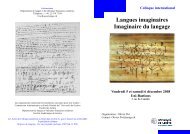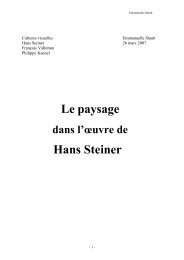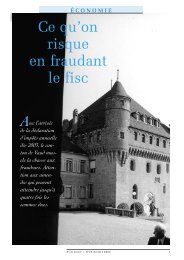conference programme book - European Survey Research ...
conference programme book - European Survey Research ...
conference programme book - European Survey Research ...
You also want an ePaper? Increase the reach of your titles
YUMPU automatically turns print PDFs into web optimized ePapers that Google loves.
164 THURSDAY 21 JULYThe evaluaon of teaching has a long history. Since the 1960s universies in the USA have measured so-calledteaching effecveness by using student evaluaon. Student evaluaon had its breakthrough in Switzerland andin most of Europe with the implementaon of the so-called Bologna system. In the Bologna declaraon of 1999,the <strong>European</strong> ministers of educaon agreed on a ”promoon of <strong>European</strong> co-operaon in quality assurancewith a view to developing comparable criteria and methodologies”. Since then, almost every university hasdeveloped ways of measuring the quality of teaching by means of students’ evaluaons. Most of these shortquesonnaires are based on assessments of the skills and the behaviour of the lecturer. Teaching outcomesare oen measured by simply asking for the overall sasfacon with the course or a similar queson...3.43.3 Addional samples with balancing or overlapping condions and given inclusion probabilies inthe framework of PISA.M. Chrisne 2 , T. ROCHER 11 Depp (Assessment, forecasng and performance directorate, Ministry of educaon), , France; 2 INSEE, FranceThis paper provides a theorecal frame and methods to solve a problem which occurs as soon as a first samplehas been drawn at a given me and that one intends later to draw a 2nd sample in an updated samplingframe, linked in a way with the 1st one, but without any possibility of changing the condions or results ofthe drawing of the former sample. The origin of this issue lies in PISA surveys (Programme for internaonalstudent assessment): the next cycle 2012 will be on the same main topic as in 2003 and it will be necessary tomake comparisons between both surveys. One of the ways to perform it is to build the 2012 sample of schoolswith overlapping condions with the 2003 sample. But it is also necessary to have the best representavenessfor the new sample. This one can be met introducing balancing condions when the new sample is drawn.Other constraints should be prescribed (fixed size, given inclusion probabilies…)...3.43.4 How Best to Collect Secondary Educaon Course-Taking Data: Student <strong>Survey</strong>s vs. Transcript AnalysisS. Kramer 1 , R. Bernotsky 3 , J. Osgood 3 , N. Wolff 21 Math Science Partnership of Greater Philadelphia, United States; 2 Arcadia University, United States; 3 WestChester University, United StatesOne of the crical issues for understanding student success in STEM (Science, Technology, Engineering andMath) disciplines in college is understanding the impact of their secondary school preparaon for college.<strong>Research</strong>ers have found that transcript analysis is a useful tool for analyzing student experiences (Adelman1999; Lee, Croninger, and Smith 1997), however, transcript data can be difficult to obtain due to privacy laws.Transcripts can be obtained with student permission, but it is difficult to get such permission since it requiresstudents to provide a social security number. <strong>Survey</strong>s are an alternave method of collecon, but there areconcerns about the accuracy of survey responses that are, by definion, self-reported data (Cole and Gonyea2010).3.44 Methodological and technical challenges in surveys of immigrant-backgroundand ethnic minority groups IITo be held on July 21, 2011 from: 16:00 to 17:30, in room 413.Coordinated by:• Mónica Méndez - Centro de Invesgaciones Sociológicas (CIS), Spain• Laura Morales - Instute for Social Change, University of Manchester, United Kingdom3.44.1 The EDCA-<strong>Survey</strong>: How Important are Sampling Technique, <strong>Survey</strong> Language and Interviewer Backgroundfor <strong>Survey</strong>ing Migrants?M. Schaeffer 1



